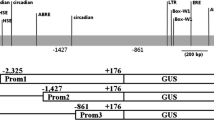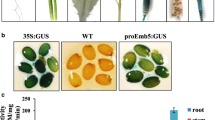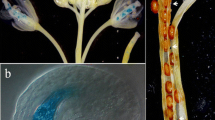Abstract
Deletions were made in the promoter of the acyl carrier protein (ACP) Acll.2 gene from Arabidopsis to investigate the nature of the cis-acting elements that direct its expression. These constructs, which included the untranslated leader region, were fused to a reporter gene coding for β-glucuronidase (GUS) and transformed into tobacco. Quantitative fluorometric analysis of GUS activity in transgenic plants showed that expression in young leaves drops to a basal level when a 85 bp domain, from -320 to -236 relative to transcription initiation, is deleted. Maximum promoter activity in roots also depends on this domain, but two other regions are also important. In total, deletion of the sequences from -466 to -55 caused an ca. 80-fold reduction in Acl1.2 promoter activity in roots. The -320 to -326 domain forms a complex with a protein factor found in leaves and roots, which was not detectable in seeds. The formation of this protein-DNA complex was abolished by mutation of a bZIP core motif, ACGT, found within the context AAGACGTAG, which is dissimilar to the other bZIP-binding sites thus far characterized in plants. Previously we showed that Acl1.2 promoter activity is highest in seeds [2]. Here we find, in contrast to leaves and roots, that deletion to position -236 has no effect on GUS levels in seeds. However, nearly a 100-fold drop was observed when the -235 to -55 region was removed. Hence, this 180 bp domain contains all the cis-acting information necessary for Acl1.2 promoter activity in seeds. The same region is necessary for Acl1.2 activity in the receptacle, stigma, tapetum and pollen of the flower, as demonstrated by histochemical staining.
Similar content being viewed by others
References
Ausubel FM, Brent R, Kingston RE, Moore DD, Seidman JG, Smith JA, Struhl K: Current Protocols in Molecular Biology. Greene Publishing Associated/Wiley-Interscience, New York (1989).
Baerson SR, Lamppa GK: Developmental regulation of an acyl carrier gene promoter in vegetative and reproductive tissues. Plant Mol Biol 22: 255–267 (1993).
Benfey PN, Ren L, Chua N-H: The CaMV 35S enhancer contains at least two domains which can confer different developmental and tissue-specific expression patterns. EMBO J 8: 2195–2202 (1989).
Bouchez D, Tokuhisa JG, Llewellyn DJ, Dennis ES, Ellis JG: The ocs-element is a component of the promoters of several T-DNA and plant viral genes. EMBO J 8: 4197–4204 (1989).
Chirala SS: Coordinated regulation and inositol-mediated and fatty acid-mediated repression of fatty acid synthase genes in Saccharomyces cerevisiae. Proc Natl Acad Sci USA 89: 10232–10236 (1992).
de Pater S, Pham K, Chua N-H, Memelink J, Kijne J: A 22-bp fragment of the pea lectin promoter containing essential TGAC-like motifs confers seed-specific gene expression. Plant Cell 5: 877–886 (1993).
deSilva J, Loader NM, Jarman C, Windust JH, Hughes SG, Safford R: The isolation and sequence analysis of two seed-expressed acyl carrier protein genes from Brassica napus. Plant Mol Biol 14: 537–548 (1990).
de Silva J, Robinson SJ, Safford R: The isolation and functional characterization of a B. napus acyl carrier protein 5′ flanking region involved in the regulation of seed storage lipid synthesis. Plant Mol Biol 18: 1163–1172 (1992).
Donald RGK, Schindler U, Batschauer A, Cashmore AR: The plant G box promoter sequence activates transcription in Saccharomyces cerecisiae and is bound in vitro by a yeast activity similar to GBF, the plant G box binding factor. EMBO J 9: 1727–1735 (1990).
Foster R, Gasch A, Kay S, Chua N-H: Analysis of protein/DNA interactions. In: Koncz C, Chua N-H, Schell J (eds) Methods in Arabidopsis Research. pp. 378–392. World Scientific Publishing, Singapore (1992).
Hannapel DJ, Ohlrogge JB: Regulation of acyl carrier protein messenger RNA levels during seed and leaf development. Plant Physiol 86: 1174–1178 (1988).
Hansen L, von Wettstein-Knowles P: The barley genes Acl1 and Acl3 encoding acyl carrier proteins I and III are located on different chromosomes. Mol Gen Genet 229: 467–478 (1991).
Harwood JL: Fatty acid metabolism. Annu Rev Plant Physiol Plant Mol Biol 39: 101–138 (1988).
Henry MF, Cronan JE: A new mechanism of transcriptional regulation: release of an activator triggered by small molecule binding. Cell 70: 671–679 (1992).
Hlousek-Radojcic A, Post-Beittenmiller D, Ohlrogge JB: Expression of constitutive and tissue-specific acyl carrier protein isoforms in Arabidopsis. Plant Physiol 98: 206–214 (1992).
Horsch RB, Fry J, Hoffmann N, Neidermeyer J, Rogers SG, Fraley RT: Leaf disc transformation. In: Gelvin SB, Schilperoort RA (eds) Plant Molecular Biology Manual, pp. A5/1-A5/9. Kluwer Academic Publishers, Dordrecht (1988).
Jefferson RA, Kavanagh TA, Bevan MW: GUS fusions: β-glucuronidase as a sensitive and versatile gene fusion marker in higher plants. EMBO J 6: 3901–3907 (1987).
Katagiri F, Lam E, Chua N-H: Two tobacco DNA-binding proteins with homology to the nuclear factor CREB. Nature 340: 727–730 (1989).
Katagiri F, Chua N-H: Plant transcription factors: present knowledge and future challenges. Trends Genet 8: 22–27 (1992).
Lam E, Benfey PN, Gilmartin PM, Fang R, Chua N-H: Site-specific mutations alter in vitro factor binding and change promoter expression pattern in transgenic plants. Proc Natl Acad Sci USA 86: 7890–7894 (1989).
Lamppa GK, Jacks C: Analysis of two linked genes coding for the acyl carrier protein (ACP) from Arabidopsis thaliana (columbia). Plant Mol Biol 16: 469–474 (1991).
MacKintosh RW, Hardie DG, Slabas AR: A new assay procedure to study the induction of β-ketoacyl-ACP synthase I and II, and the complete purification of β-ketoacyl-ACP synthase I from developing seeds of oilseed rape (Brassica napus). Biochim Biophys Acta 1002: 114–124 (1989).
McKendree WL, Paul AL, DeLisle AJ, Ferl RJ: In vivo and in vitro characterization of protein interactions with the dyad G-box of the Arabidopsis Adh gene. Plant Cell 2: 207–214 (1990).
Ohlrogge JB, Kuhn DN, Stumpf PK: Subcellular localization of acyl carrier protein in leaf protoplasts of Spinacia oleracea. Proc Natl Acad Sci USA 76: 1194–1198 (1979).
Ohlrogge JB, Kuo TM: Spinach acyl carrier protein: Primary structure, mRNA translation and immunoelectrophoretic analysis. In: Siegenthaler P-A, Eichenberger W (eds) Structure, Function and Metabolism of Plant Lipids, pp. 63–67. Elsevier Science Publishers, Amsterdam (1984).
Ohlrogge JB, Kuo TM: Plants have isoforms for acyl carrier protein that are expressed differently in different tissues. J Biol Chem 260: 8032–8037 (1985).
Ohlrogge JB, Browse J, Somerville CR: The genetics of plant lipids. Biochim Biophys Acta 1082: 1–26 (1991).
Post-Beittenmiller MA, Schmid KM, Ohlrogge JB: Expression of holo and apo forms of spinach acyl carrier protein-I in leaves of transgenic tobacco plants. Plant Cell 1: 889–899 (1989).
Rogers SG, Klee H, Horsch RB, Fraley RT: Use of cointegrating Ti plasmid vectors. In: Gelvin SB, Schilperoort RA (eds) Plant Molecular Biology Manual, pp. A2/1-A2/12. Kluwer Academic Publishers, Dordrecht (1988).
Sanger F, Nicklen S, Coulson AR: DNA sequencing with chain-terminating inhibitors. Proc Natl Acad Sci USA 74: 5463 (1977).
Safford R, Windust JHC, Lucas C, deSilva J, James CM, Hellyer A, Smith CG, Slabas AR, Hughes G: Plastidlocalized seed acyl-carrier protein of Brassica napus is encoded by a distinct, nuclear multigene family. Eur J Biochem 174: 287–295 (1988).
Sambrook J, Fritsch EF, Maniatis T: Molecular Cloning: A Laboratory Manual. Cold Spring Harbor Laboratory Press, Cold Spring Harbor, NY (1989).
Scherer DE, Knauf VC: Isolation of a cDNA clone for the acyl carrier protein-I of spinach. Plant Mol Biol 9: 127–134 (1987).
Schindler U, Beckmann H, Cashmore AR: TGA1 and G-box binding factors: two distinct classes of Arabidopsis leucine zipper proteins compete for the G-box-like element TGACGTGG. Plant Cell 4: 1309–1319 (1992).
Schindler U, Terzaghi W, Beckmann H, Kadesch T, Cashmore AR: DNA binding site preferences and transcriptional activation properties of the Arabidopsis transcription factor GBF1. EMBO J 11: 1275–1289 (1992).
Schuller H-J, Hahn A, Troster F, Schutz A, Schweizer E: Coordinate genetic control of yeast fatty acid synthase genes FAS1 and FAS2 by an upstream activation site common to genes involved in membrane lipid biosynthesis. EMBO J 11: 107–114 (1992).
Shimakata T, Stumpf PK: Purification and characterization of β-ketoacyl-[acyl-carrier-protein] reductaser, β-hydroxyacyl-[acyl-carrier-protein] dehgydratase and enoyl-[acyl-carrier-protein] reductase from Spinacea oleracea. Arch Biochem Biophys 218: 77–91 (1982).
Slabas AR, Cottingham IR, Austin A, Hellyer A, Safford R, Smith CG: Immunological detection of NADH-specific enoyl-ACP reductase from rape seed (Brassica napus): induction, relationship of α and β polypeptides, mRNA translation and interaction with ACP. Biochim biophys Acta 1039: 181–188 (1990).
Stumpf PK: The biosynthesis of saturated fatty acids. In: Stumpf PK, Conn EE (eds) The Biochemistry of Plants, pp. 121–136. Academic Press, Orlando, FL (1987).
Tabata T, Takase H, Takayama S, Mikami K, Nakatsuka A, Kawata T, Nakayama T, Iwabuchi M: A protein that binds to a cis-acting element of wheat histone genes has a leucine zipper motif. Science 245: 965–967 (1989).
Tabata T, Nakayama T, Mikami K, Iwabuchi M: HBP-1a and HBP-1b: leucine zipper-type transcription factors of wheat. EMBO J 10: 1459–1467 (1991).
Thomas TL: Gene expression during plant embryogenesis and germination: an overview. Plant Cell 5: 1401–1410 (1993).
Wakil SJ, Stoops JK, Joshi VC: Fatty acid synthesis and its regulation. Annu Rev Biochem 52: 537–579 (1983).
Yamazaki K, Katagiri F, Imaseki H, Chua N-H: TGA1a, a tobacco DNA-binding protein, increases the rate of initiation in a plant in vivo transcription system. Proc Natl Acad Sci USA 87: 7035–7039 (1990).
Yuan Z, Liu W, Hammes GG: Molecular cloning and sequencing of DNA complementary to chicken liver fatty acid synthase mRNA. Proc Natl Acad Sci USA 85: 6328–6331 (1988).
Zar JH: Biostatistical Analysis. Prentice-Hall, Englewood Cliffs, NJ (1984).
Author information
Authors and Affiliations
Rights and permissions
About this article
Cite this article
Baerson, S.R., Vander Heiden, M.G. & Lamppa, G.K. Identification of domains in an Arabidopsis acyl carrier protein gene promoter required for maximal organ-specific expression. Plant Mol Biol 26, 1947–1959 (1994). https://doi.org/10.1007/BF00019505
Received:
Accepted:
Issue Date:
DOI: https://doi.org/10.1007/BF00019505




